Tab.1 Structural parameters of ZnO varistors

厂家阀片直径/mm高度/mmU1mA/kV质量/kg AA15223.55.270.272 A26222.84.970.366 A38521.84.970.684 BB110520.03.960.934 B26030.56.660.311
摘要 自然界中大部分闪电都包含多次回击过程,连续雷击容易造成避雷器劣化及损坏。该文使用不同电流幅值、脉冲间隔、冲击次数的连续雷击对五种不同尺寸的避雷器阀片进行试验,研究了避雷器阀片在连续雷击下的电气性能。结果表明:不同的冲击时间间隔(10、50、100 ms)下避雷器阀片的电气性能变化差别不大,在ms量级的冲击间隔时间下阀片散热可忽略不计,可视作为绝热过程;雷电流的幅值和冲击次数对避雷器阀片的电气性能有较大影响,冲击电流幅值越高,冲击次数越多,避雷器阀片的伏安曲线下移越明显,直流参考电压减小越显著,残压略微增加;温度是影响阀片性能的重要因素,温度越高,阀片性能劣化越严重,再次受到冲击后的劣化速度也会加快;避雷器阀片的温升与吸收能量和质量的比值呈现显著线性关系。
关键词:氧化锌避雷器阀片 连续雷击试验 电气性能 温度
氧化锌避雷器由于其优良的非线性伏安特性及良好的通流能力,被广泛应用于电力系统中来限制操作或雷电过电压,保护电力设备的安全运行[1-2]。根据大量的雷电自然观测及人工触发闪电观测发现,自然界中超过70%的地闪都包含几次大电流脉冲过程,这些大电流脉冲过程被称为回击[3-4],回击之间的间隔时间一般为几十毫秒到几百毫秒之间。多次回击会对避雷器产生更加严重的影响,从而危害电网安全运行。
K. Eda等[5-6]研究了非线性氧化锌陶瓷的老化机理,以及大电流作用下压敏电阻的微观破坏机理。张树高等[7]在此基础上提出线性链理论,进一步解释了压敏电阻在老化时非线性减弱甚至消失的现象。D. T. Khanmiri等[8]使用单极性和双极性浪涌发现,在一定的过电压下,发生老化的压敏电阻的能量吸收能力和故障时间会反常增加。王建国等[9]研究了压敏电阻的归一化参数与压敏电阻直径的关系。K. G. Ringler等[10]通过试验确定了电站类避雷器中使用的压敏电阻在0.8 A~35 kA电流水平下的能量吸收能力。N. Tsukamoto等[11]着重于测试电流的波形,使用2 ms方波、4/10 μs及10/350 μs的冲击电流研究压敏电阻耐受重复脉冲的能力,并讨论了机械失效及电器失效的机理。Zhang Chunlong等[12]使用间隔时间为50 ms的8/20 μs标准雷电流进行五脉冲冲击试验,发现阀片的破坏机制为多重雷电流引起的温度梯度热应力导致的热损伤和晶界结构损伤。李鹏飞等[13-14]研究了金属氧化物避雷器在多脉冲雷电冲击下的破坏形式,发现多脉冲雷电冲击ZnO压敏电阻本身产生的热应力为其劣化损坏的主要原因。何雨微等[15]指出在多波形多脉冲电流下,氧化锌阀片受到焦耳加热和热应力的影响而损坏。曹洪亮等[16]研究了冲击老化过程中温度对泄漏电流的影响,指出泄漏电流受温度影响较大,温度上升会导致泄漏电流增大,电阻片的功率损耗增大,温度进一步上升,形成恶性循环。B. H. Lee和江安烽等[17-18]使用不同波形参数的多重脉冲,研究了压敏电阻在冲击电压下的失效模式。A. F. Andrade和Huang Lin等[19-20]使用有限元方法,对避雷器在雷击下的热效应进行了仿真计算。黎鹏等[21]使用场路耦合的方法,计算了避雷器在多重雷电绕击500 kV直流输电线路时避雷器的温升,指出多重雷击下长连续电流会使避雷器更容易发生热崩溃。蔡力等[22-23]针对整只避雷器研究了其在雷电流冲击下的热特性及耐受冲击能力。廖民传等[24]对南方电网范围内沿线落雷进行统计,认为有28.33%的落雷都有可能是多重雷击,并分析了多重雷击对于线路避雷器的影响。文献[25-27]分别研究了不同电压等级的避雷器耐受冲击的能力。周利军等[28]研究了多重雷击下氧化锌避雷器的老化特性。
雷电冲击耐受能力测试是考察和检验避雷器保护水平和性能的必要试验。由于现行的标准只对避雷器的单次大电流冲击有要求[29],因而目前的试验方法和装置在短时间内大多只能进行雷电流单次试验的模拟。由于多次重复试验充放电时间在几十秒以上,无法模拟及考察μs~ms时间间隔的雷电流多次回击时的电动力效应及热效应累积,而这类效应的模拟和试验对于避雷器性能的考察十分重要。
本文选择不同尺寸的避雷器阀片开展连续雷击试验,研究不同电流幅值、脉冲间隔以及冲击次数的连续雷击对避雷器阀片电气性能的影响,并分析温度对阀片电气性能的影响。
本次试验选取了来自两个厂家的5种不同尺寸的避雷器阀片,编号分别为A1、A2、A3和B1、B2,这些阀片中A1、A2及B2是用于110 kV电压等级的避雷器阀片;B1是用于500 kV电压等级的避雷器阀片;A3是用于220 kV电压等级的避雷器阀片。阀片的结构参数见表1,表中,U1mA为直流1 mA参考电压。
为了研究不同类型连续雷击对避雷器阀片电气性能的影响,通过调整连续雷击的次数、时间间隔以及冲击电流幅值对避雷器阀片进行冲击试验,得到避雷器阀片在耐受不同连续雷击时电气特性的变化。每种阀片根据其额定通流能力使用3种不同大小的电流幅值进行试验,连续雷击次数分别设置为1、2、3次。廖民传等[24]统计南方电网范围内75条输电线路沿线的12 763次落雷发现,28.33%的落雷时间间隔小于0.1 s,因此本试验将时间间隔设置为10、50和100 ms。试验波形为标准8/20 μs冲击电流波形。
表1 避雷器阀片结构参数
Tab.1 Structural parameters of ZnO varistors

厂家阀片直径/mm高度/mmU1mA/kV质量/kg AA15223.55.270.272 A26222.84.970.366 A38521.84.970.684 BB110520.03.960.934 B26030.56.660.311
连续雷击侵入波过电压试验原理如图1所示,试验装置实物如图2所示。图1中,T为变压器,R为保护电阻,R0为调波电阻,VD为高压硅堆,C1、C2、C3为主电容器,G1、G2、G3为放电球隙,R1和R2组成分压器。主电容器组充电到电压设定值后,通过脉冲点火器使放电球隙按照设定的时间间隔放电,电容器组C1、C2、C3分别经L1、L2、L3及试品放电。分压器和罗氏线圈分别用来测量试品上的残压和流经试品的电流,示波器记录冲击电流及残压波形。
连续雷击试验的流程如下:首先,在进行连续冲击前测量阀片的初始伏安曲线;然后,利用连续雷击侵入波过电压试验平台对阀片进行连续冲击,调整连续雷击的电流幅值、脉冲间隔、冲击次数进行冲击试验;最后,利用红外热像仪监测阀片的实时温度,并在冲击后及阀片恢复室温后测量阀片的伏安曲线。

图1 连续雷击侵入波过电压试验原理
Fig.1 Schematic diagram of continuous lightning stroke test

图2 连续雷击试验装置实物
Fig.2 Multiple impulse lightning test device
对于5种不同规格大小的阀片,首先控制3次脉冲的时间间隔分别为10、50和100 ms,同时保持冲击电流的幅值不变进行冲击试验。
每次冲击后测量避雷器阀片的温升、U1mA、残压及吸收能量等参数,其结果见表2。图3和图4分别给出了A1阀片在3次幅值为20 kA、间隔为10 ms的电流冲击下的残压波形,以及其在不同时间间隔的冲击电流作用下最后达到的温度。可以看到,在不同时间间隔的冲击电流作用下,阀片的残压基本相同,最后达到的温度也基本相同,都超过了97℃。对于阀片A1,冲击峰值电流为20 kA时,最大和最小温升相差1.2 K,能量注入相差1.4%,U1mA变化率分别为-8.7%、-8.3%和-8.2%,在相同幅值的冲击电流作用下,阀片的U1mA的变化率是相似的。对于阀片A2,冲击电流峰值为24 kA时,最大最小温升相差2.1 K,能量注入相差0.8%,U1mA变化率分别为-7.8%、-7.4%和-8.0%。对于阀片A3,冲击电流峰值为24 kA时,最大最小温升相差1.4 K,能量注入相差1.9%,U1mA变化率分别为-6.8%、-6.8%和-6.4%。对于阀片B1,冲击电流峰值为26 kA时,最大最小温升相差1.3 K,能量注入相差1.7%,U1mA变化率分别为-2.8%、-1.0%和-1.3%。对于阀片B2,冲击电流峰值为10 kA时,最大最小温升相差1.3 K,能量注入相差1.1%,U1mA变化率分别为-2.7%、-2.4%和-2.1%。
表2 不同冲击时间间隔连续雷击试验结果
Tab.2 Experimental results of continuous lightning stroke at different time intervals
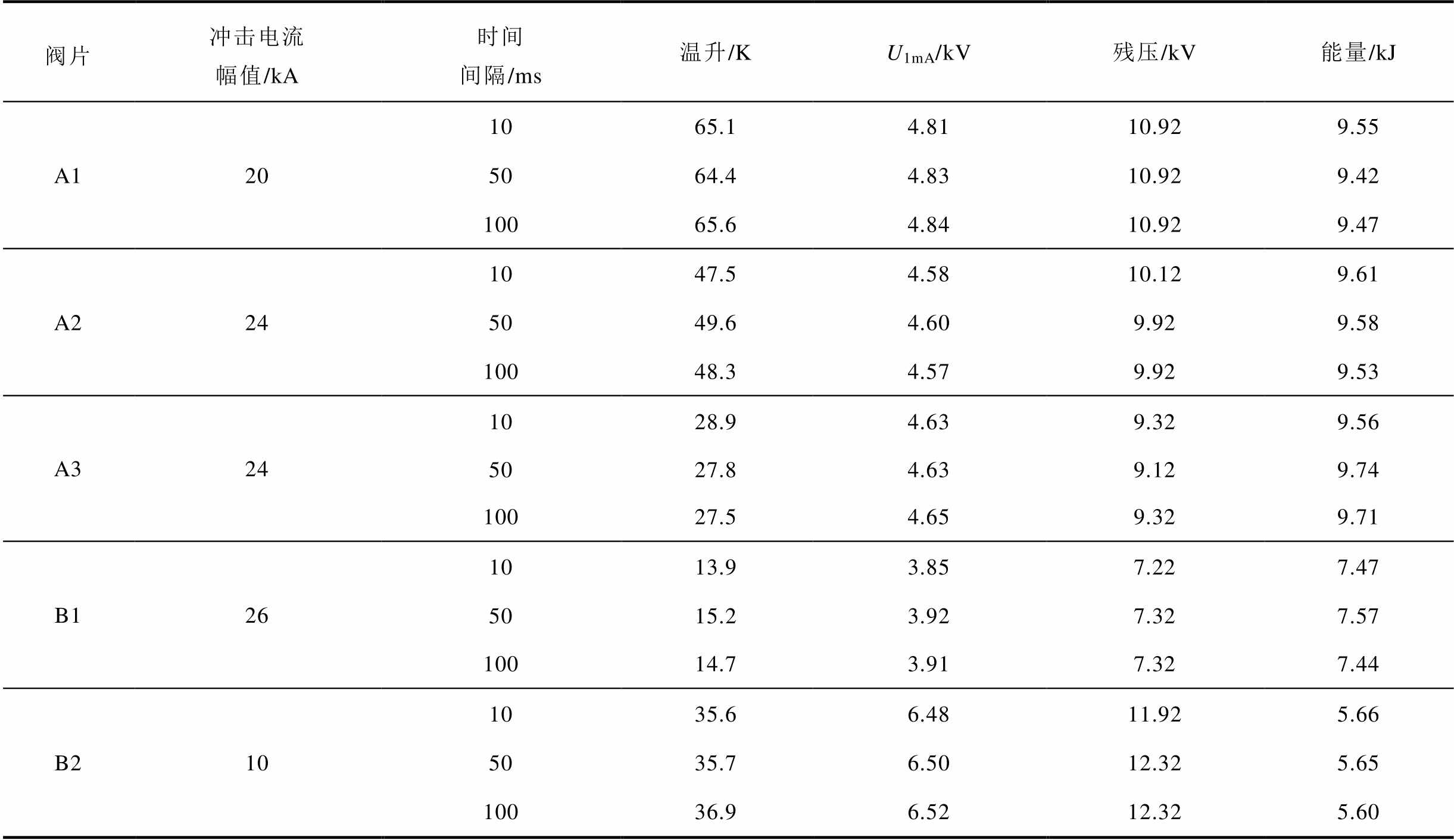
阀片冲击电流幅值/kA时间间隔/ms温升/KU1mA/kV残压/kV能量/kJ A1 201065.14.8110.929.55 5064.44.8310.929.42 10065.64.8410.929.47 A2 241047.54.5810.129.61 5049.64.609.929.58 10048.34.579.929.53 A3 241028.94.639.329.56 5027.84.639.129.74 10027.54.659.329.71 B1 261013.93.857.227.47 5015.23.927.327.57 10014.73.917.327.44 B2 101035.66.4811.925.66 5035.76.5012.325.65 10036.96.5212.325.60
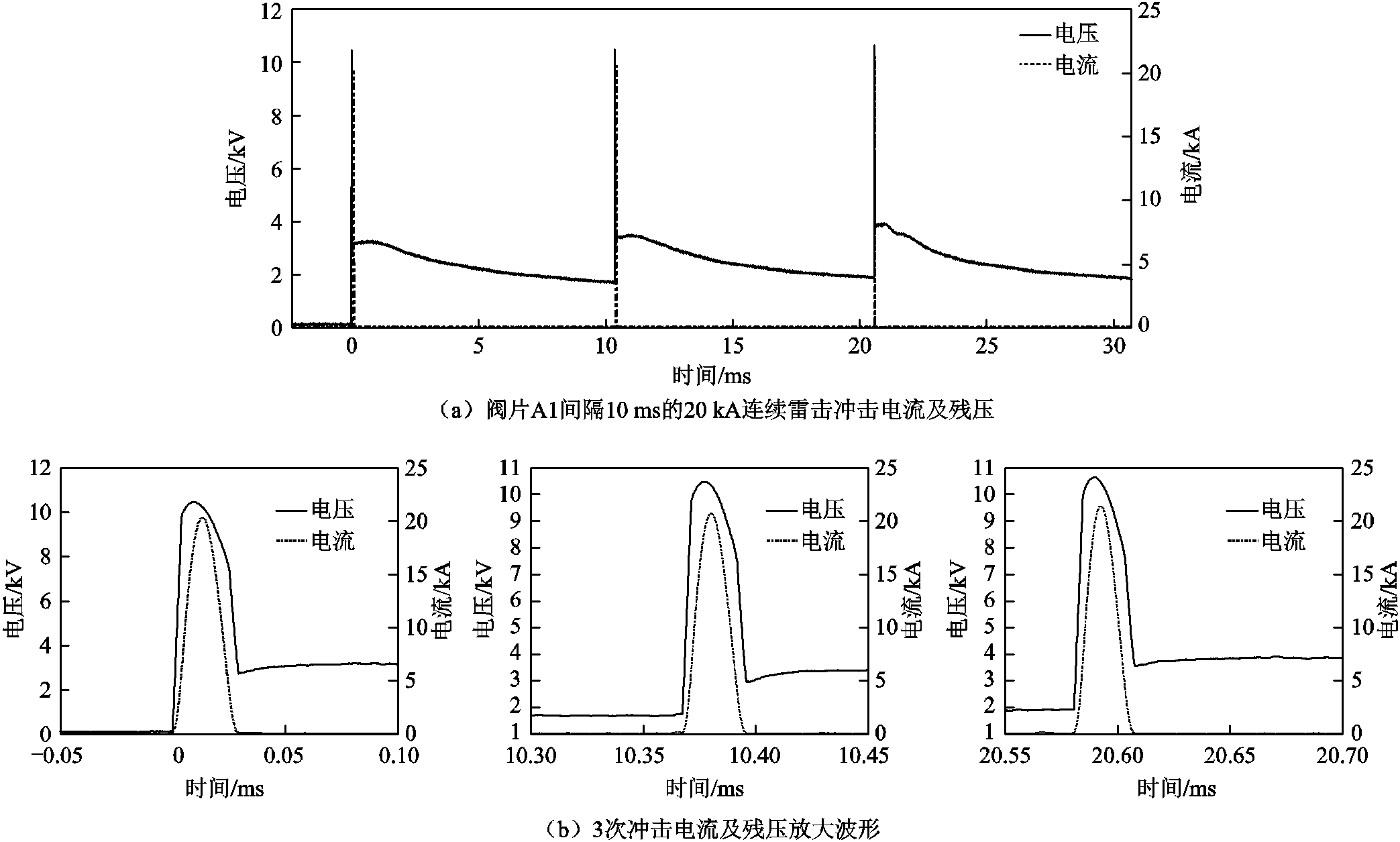
图3 连续雷击试验冲击电流及残压
Fig.3 Impulse current and residual voltage of continuous lightning stroke test

图4 阀片A1在电流幅值20 kA下不同间隔时间的温度
Fig.4 Temperature of A1 at different intervals under current amplitude of 20 kA
图5给出了冲击后阀片的温升及U1mA与冲击电流时间间隔的关系。可见,温升与冲击时间间隔之间无明确的相关性,并且阀片在冲击后的U1mA并不随着冲击时间间隔的变化而变化。因此,对比不同厂家不同尺寸的避雷器阀片在不同时间间隔的连续雷击下的试验结果可以发现,多脉冲冲击的时间间隔对于冲击后阀片温升、U1mA和残压的影响都不大。
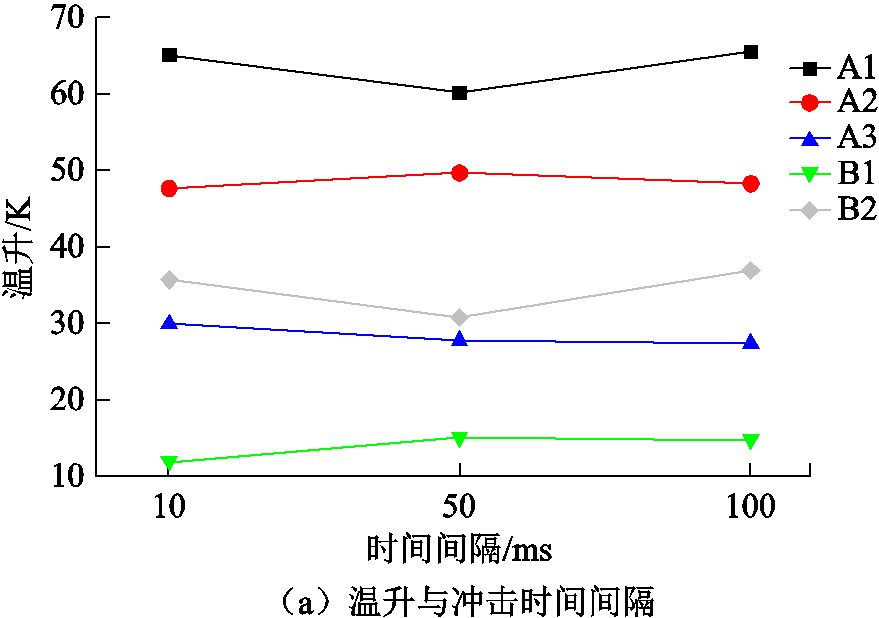
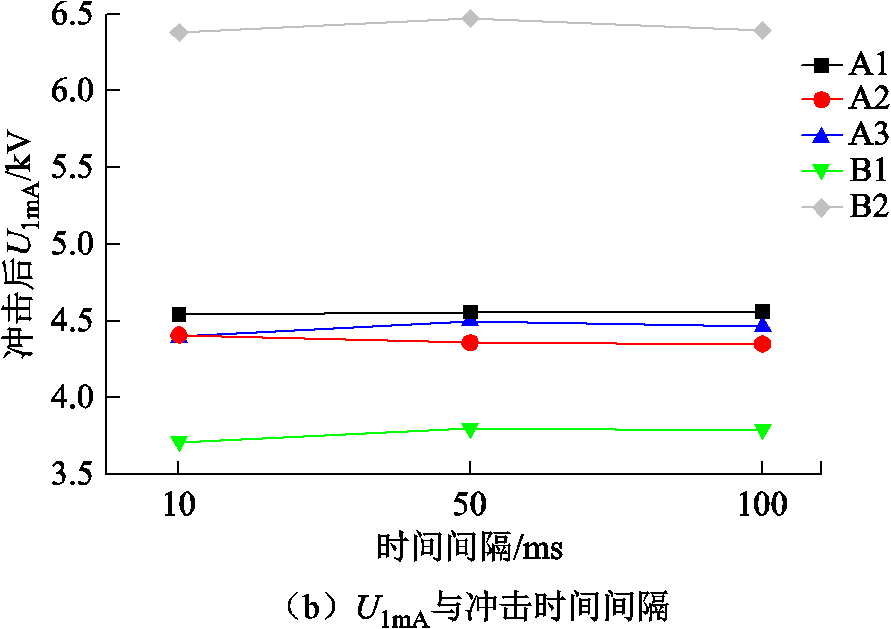
图5 冲击后阀片温升和参考电压与冲击时间间隔的关系
Fig.5 Relationship between temperature rise impact
表3给出了不同尺寸阀片在10 ms的冲击时间间隔下冲击前后及恢复室温后的U1mA,可以看到避雷器阀片在连续雷电冲击后其U1mA明显下降,但是待阀片恢复为室温后,其U1mA相比冲击前没有明显变化,电气性能得到完全恢复。这表明温度对于阀片的电气特性有重要影响。
表3 连续雷击试验前后避雷器阀片U1mA
Tab.3 U1mA of arrester before and after multiple lightning test

阀片U1mA/kV 初始冲击后恢复室温 A15.374.815.30 A25.084.585.00 A35.034.635.05 B14.163.854.14 B26.846.486.86
避雷器阀片的电气性能与温度密切相关。而温度变化与阀片吸收的能量有关。阀片吸收的能量E(单位为J)为
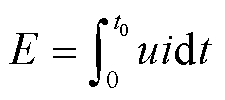 (1)
(1)
式中,u为残压,V;i为冲击电流,A;t0为电流持续时间,s。阀片的温升ΔT(单位为K)和注入能量E的关系为
 (2)
(2)
式中,c为比热容,kJ/(kg·K);m为质量,kg。
利用式(2),根据表2的试验结果可以计算阀片的比热容,结果见表4。所有阀片的比热容计算平均值在0.5~0.6 kJ/(kg·K)之间,可见不同厂家之间的避雷器阀片的比热容相似,因此阀片的温升取决于阀片本身的质量和注入的能量,注入的能量越多,阀片的温升越高,电气性能变化更明显。
表4 避雷器阀片的比热容计算结果
Tab.4 Calculation results of specific heat capacity of ZnO varistors

脉冲间隔/ms比热容/[kJ/(kg·K)] A1A2A3B1B2 100.540.550.470.670.51 500.580.530.510.530.59 1000.530.540.520.540.49 平均0.550.540.500.580.53
本节试验仅改变了冲击时间间隔,电流幅度保持不变,对于同一种试品试验中注入的总能量基本相同,同时由于冲击间隔时间为ms量级,在这期间阀片的散热可忽略不计,视为绝热过程,因此最终温升一致,也就是说,改变脉冲的时间间隔,对阀片的电气性能影响有限。
保持电流脉冲之间的时间间隔为100 ms,改变冲击电流的幅值,得到的不同冲击电流幅值下的试验结果见表5。
表5 不同冲击电流幅值连续雷击试验结果
Tab.5 Experimental results of continuous lightning stroke with different impulse current amplitudes

阀片电流/kA温升/KU1mA/kV残压/kV能量/kJ A11040.05.219.724.55 1545.95.1110.327.01 2065.64.8410.929.47 A21227.64.959.124.94 1838.34.879.527.37 2448.34.579.929.53 A31219.04.908.725.07 1817.24.889.127.45 2427.54.659.329.71 B12015.93.907.125.54 2614.73.917.327.44 3223.43.677.529.36 B2520.96.6311.723.18 1036.96.5212.325.60 1543.26.3512.928.32
冲击电流幅值越大,连续雷击后阀片的U1mA的值越小。随着电流增大,与初始U1mA对比,阀片A1的U1mA分别减小了1.1%、3.0%和8.2%,阀片A2分别减小了0.4%、2.0%和8.0%;阀片A3分别减小了1.4%、1.8%和6.4%,阀片B1分别减小了1.5%、1.3%和7.3%,阀片B2分别减小了0.5%、2.1%和3.0%。
图6给出了阀片残压及U1mA与电流幅值的关系曲线。可以看到,随着冲击电流幅值的线性增大,阀片的残压呈现出线性增加,但是增加幅度不大;然而其U1mA却不是线性下降的,当冲击电流越大,即使冲击电流变化量相同,阀片的U1mA也下降越多。由于更大的冲击电流使得阀片的温度更高,也就是说,即使温升相同,温度更高的阀片其U1mA下降幅度更大。因此,温度越高,避雷器阀片电气性能劣化程度越严重。

图6 阀片残压及U1mA与冲击电流幅值的关系
Fig.6 Relation between residual voltage of ZnO varistors as well as U1mA and amplitude of impulse current
利用本次试验的数据,对温升 及能量和质量比E/m进行拟合,得到图7所示的关系。可见,ΔT和E/m呈现高度线性的关系,而直线斜率的倒数代表比热容,这表明这些阀片的比热容基本一致。拟合出的阀片比热容为0.53 kJ/(kg·K),与表4中计算出的阀片比热容一致。
及能量和质量比E/m进行拟合,得到图7所示的关系。可见,ΔT和E/m呈现高度线性的关系,而直线斜率的倒数代表比热容,这表明这些阀片的比热容基本一致。拟合出的阀片比热容为0.53 kJ/(kg·K),与表4中计算出的阀片比热容一致。
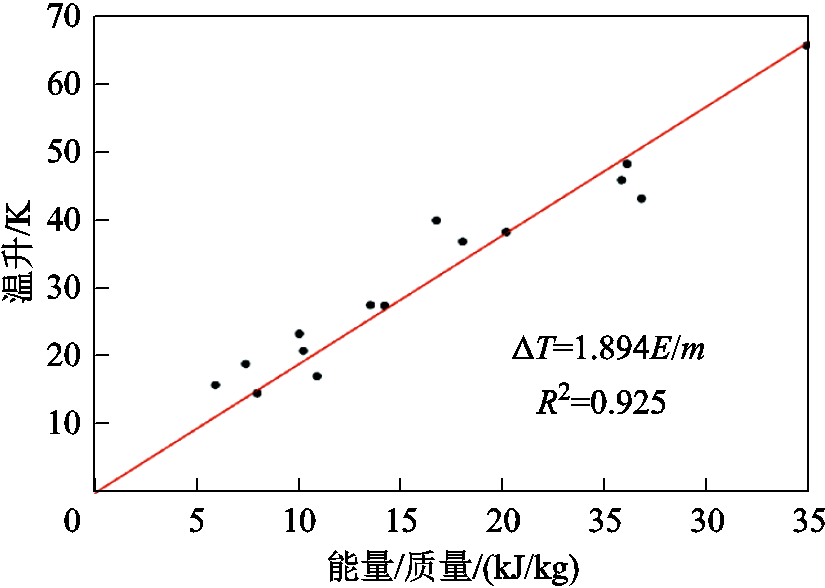
图7 阀片的温升与注入能量和质量的关系
Fig.7 Relationship with temperature rise, injected energy and the weight of ZnO varistors
改变冲击的次数,保证每次冲击时冲击电流的幅值不变,同时设定冲击间隔时间为100 ms(对于两次和三次冲击),得到试验结果见表6。
表6 不同冲击次数连续雷击试验结果
Tab.6 Experimental results of continuous lightning stroke with different impulse times
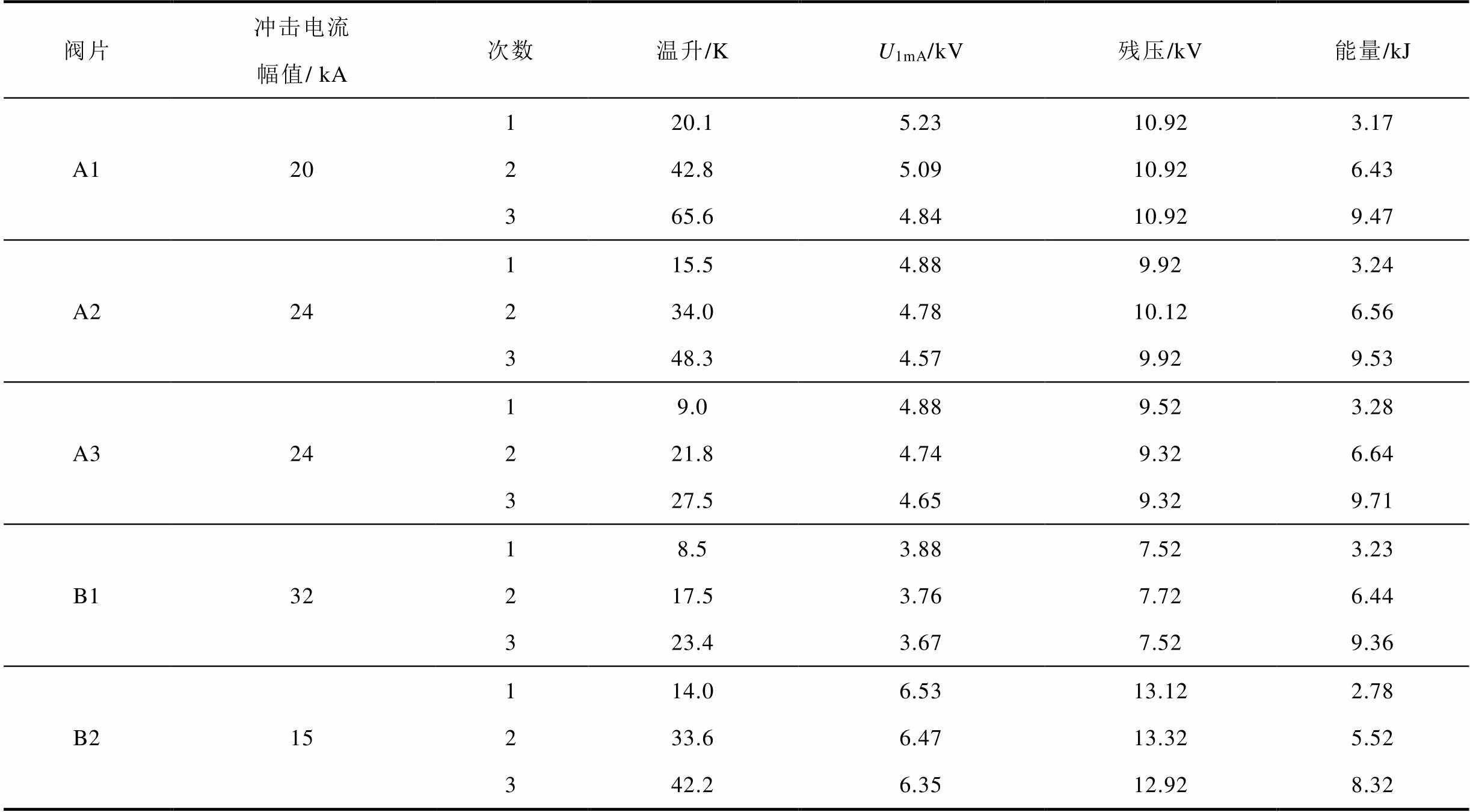
阀片冲击电流幅值/ kA次数温升/KU1mA/kV残压/kV能量/kJ A1 20120.15.2310.923.17 242.85.0910.926.43 365.64.8410.929.47 A224115.54.889.923.24 234.04.7810.126.56 348.34.579.929.53 A32419.04.889.523.28 221.84.749.326.64 327.54.659.329.71 B13218.53.887.523.23 217.53.767.726.44 323.43.677.529.36 B215114.06.5313.122.78 233.66.4713.325.52 342.26.3512.928.32
避雷器阀片的温升随冲击次数增加而增加,但避雷器阀片的残压没有出现明显的变化。阀片A1的U1mA在1、2、3次冲击后较初始值分别减小了0.8%、3.8%和8.5%;阀片A2分别减小了1.8%、4.0%和8.0%;阀片A3分别减小了1.8%、5.4%和6.6%;阀片B1分别减小了2.0%、5.1%和7.3%;阀片B2分别减小了2.0%、3.2%和4.2%。但是改变冲击次数并不会改变阀片的残压。
增加冲击的次数,阀片吸收的能量会成倍增长,导致其温度大幅上升。图8给出了阀片冲击后U1mA与冲击次数的关系,可以看到,随着冲击次数的增加,阀片的U1mA呈现出与2.2节中相似的加速下降情况,这也同时印证了2.2节中温度越高,劣化越严重的结论。
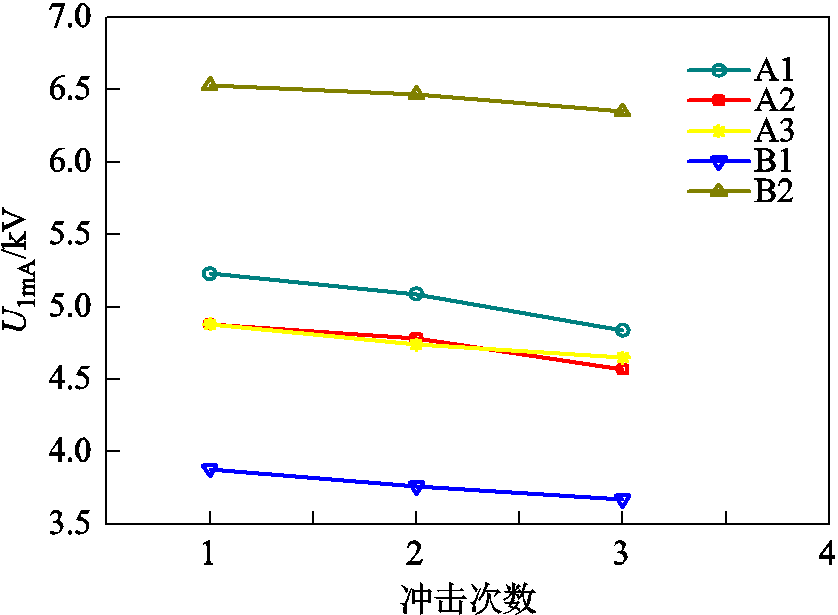
图8 阀片U1mA和冲击次数的关系
Fig.8 Relation between U1mA and the number of the impulses
根据本组试验结果中ΔT和E/m的线性拟合计算避雷器阀片的比热容,结果如图9所示,和不同电流幅值下连续雷击试验的计算结果相似,两者呈现明显的线性关系。根据式(2)得出阀片的比热容为0.54 kJ/(kg·K),和2.2节计算得出的0.53 kJ/(kg·K)基本相同。由于这三节中比热容的计算结果相似,因而认为可通过阀片吸收的能量来计算阀片的温升,并根据温度对阀片电气性能的影响来判断阀片性能变化情况。
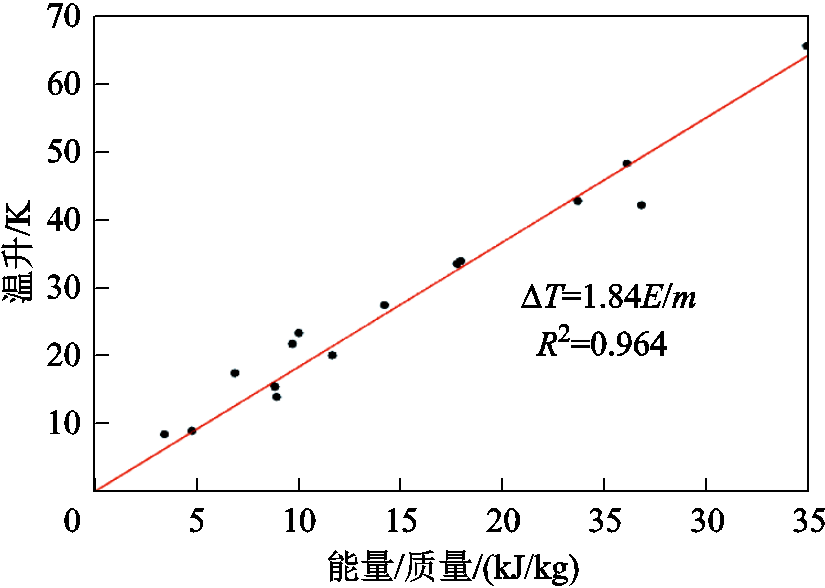
图9 阀片的温升与注入能量/质量的关系
Fig.9 Relationship with temperature rise, injected energy and mass of ZnO varistors
1)连续脉冲电流冲击会使得阀片在短时间内吸收大量能量,产生较高温升,进而使其电气性能严重劣化,但是在温度恢复后其电气性能也会恢复。
2)连续雷击试验中的时间间隔(ms量级)对于阀片电气性能变化影响较小,在ms量级的冲击间隔时间下阀片的散热可忽略不计,视为绝热过程,同一阀片在不同时间间隔的冲击作用下最终温升一致,导致其电气性能变化不大。
3)雷电流的幅值和冲击次数对避雷器阀片电气性能有较大影响,冲击电流幅值越高,冲击次数越多,避雷器阀片的伏安曲线下移越明显,直流1 mA参考电压减小越显著;而残压会随着电流幅值增大而略微增加。
4)温度是影响阀片电气性能的重要因素,温度越高,影响效果越显著,避雷器阀片的温升与吸收能量和质量的比值呈现强线性关系。可以通过阀片吸收的能量来计算阀片的温升,并根据温度对阀片电气性能的影响来判断阀片劣化情况。
参考文献
[1] Imai T, Udagawa T, Ando H, et al. Development of high gradient zinc oxide nonlinear resistors and their application to surge arresters[J]. IEEE Transactions on Power Delivery, 1998, 13(4): 1182-1187.
[2] Brito V S, Lira G R S, Costa E G, et al. A wide-range model for metal-oxide surge arrester[J]. IEEE Transactions on Power Delivery, 2018, 33(1): 102-109.
[3] 蔡力, 柯逸丰, 李进, 等. 基于高速摄像观测的风电场雷击风机发展过程和特性分析[J]. 电工技术学报, 2021, 36(增刊1): 303-310. Cai Li, Ke Yifeng, Li Jin, et al. Development process and characteristic analysis of the natural lightning strike on wind turbine based on high-speed camera observation[J]. Transactions of China Electrotechnical Society, 2021, 36(S1): 303-310.
[4] 刘亚坤, 戴明秋, 毕晓蕾, 等. 三种冲击电流连续作用下铝3003合金的损伤特性[J]. 电工技术学报, 2020, 35(6): 1173-1180. Liu Yakun, Dai Mingqiu, Bi Xiaolei, et al. Damage characteristics of Al alloy 3003 suffered from three continuous impulse currents[J]. Transactions of China Electrotechnical Society, 2020, 35(6): 1173-1180.
[5] Eda K. Destruction mechanism of ZnO varistors due to high currents[J]. Journal of Applied Physics, 1984, 56(10): 2948-2955.
[6] Eda K, Iga A, Matsuoka M. Degradation mechanism of non‐Ohmic zinc oxide ceramics[J]. Journal of Applied Physics, 1980, 51(5): 2678-2684.
[7] 张树高, 季幼章. 氧化锌压敏电阻的老化机理[J]. 功能材料, 1993, 24(6): 529-532. Zhang Shugao, Ji Youzhang. Degradation mechanism of ZnO varistors[J]. Journal of Functional Materials, 1993, 24(6): 529-532.
[8] Khanmiri D T, Ball R, Lehman B. Degradation effects on energy absorption capability and time to failure of low voltage metal oxide varistors[J]. IEEE Transactions on Power Delivery, 2017, 32(5): 2272-2280.
[9] Wang Jianguo, Mei Linmao, Su Wanlu, et al. Impulse current withstanding capability of ZnO varistors with influence of varistor size[J]. IEEJ Transactions on Electrical and Electronic Engineering, 2019, 14(7): 1016-1022.
[10] Ringler K G, Kirkby P, Erven C C, et al. The energy absorption capability and time-to-failure of varistors used in station-class metal-oxide surge arresters[J]. IEEE Transactions on Power Delivery, 1997, 12(1): 203-212.
[11] Tsukamoto N, Ishii M. Repetitive impulse withstand performance of metal–oxide varistors[J]. IEEE Transactions on Power Delivery, 2017, 32(4): 1674-1681.
[12] Zhang Chunlong, Xing Hongyan, Li Pengfei, et al. An experimental study of the failure mode of ZnO varistors under multiple lightning strokes[J]. Electronics, 2019, 8(2): 172.
[13] 李鹏飞, 张春龙, 吕东波, 等. 多脉冲雷电冲击下金属氧化物的破坏形式[J]. 高电压技术, 2017, 43(11): 3792-3799. Li Pengfei, Zhang Chunlong, Lü Dongbo, et al. Failure modes of metal oxide arrestor under the multi-pulse lightning surges[J]. High Voltage Engineering, 2017, 43(11): 3792-3799.
[14] Zhang Chunlong, Xing Hongyan, Li Chunying, et al. Micro-degradation characteristics and mechanism of ZnO varistors under multi-pulse lightning strike[J]. Energies, 2020, 13(10): 2620.
[15] He Yuwei, Wei Bengang, Fu Zhengcai, et al. MOV failure modes and microstructural characteristics under operating duty tests with multiwaveform multipulse currents[J]. IEEE Transactions on Power Delivery, 2018, 33(5): 2274-2283.
[16] 曹洪亮, 谭涌波, 陈则煌, 等. 压敏电阻冲击老化过程中温度对静态参数影响分析[J]. 电瓷避雷器, 2015(6): 159-162. Cao Hongliang, Tan Yongbo, Chen Zehuang, et al. Analysis of the temperature influence on the static parameter during the process of varistor impulse degradation[J]. Insulators and Surge Arresters, 2015(6): 159-162.
[17] Lee B H, Kang S M. Properties of ZnO varistor blocks under multiple lightning impulse voltages[J]. Current Applied Physics, 2006, 6(5): 844-851.
[18] Jiang Anfeng, Fu Zhengcai, Sun Wei, et al. Experimental and analytical studies of the effects of multiple lightning impulse currents on metal-oxide arrester blocks[C]//2014 International Conference on Lightning Protection (ICLP), Shanghai, China, 2014: 681-687.
[19] Andrade A F, Fernandes J M B, Alves H M M, et al. Thermal behavior analysis in a porcelain-housed ZnO surge arrester by computer simulations and thermography[C]//2018 IEEE International Conference on High Voltage Engineering and Application (ICHVE), Athens, Greece, 2019: 1-4.
[20] Huang Lin, Zhou Lijun, Chen Wei, et al. Analysis of thermal effects for polymer-housed metal-oxide surge arrester under multiple strokes[J]. IEEE Transactions on Power Delivery, 2022, 37(5): 3917-3927.
[21] 黎鹏, 肖盼, 屈莹莹, 等. 带长连续电流多重回击作用下500kV避雷器温升特性分析[J]. 电工技术学报, 2020, 35(增刊2): 603-611. Li Peng, Xiao Pan, Qu Yingying, et al. Temperature rise characteristics of 500kV arrester under the action of multiple return-strokes with long continuous current[J]. Transactions of China Electrotechnical Society, 2020, 35(S2): 603-611.
[22] Cai Li, Yu Wenbo, Wang Jianguo, et al. Study on the thermal behaviour and non-linear coefficient of the 10kV ZnO surge arrester[J]. IET Generation, Transmission & Distribution, 2020, 14(22): 5287-5293.
[23] 彭向阳, 王保山, 彭发东, 等. 整只配网用避雷器大电流耐受能力试验研究[J]. 高电压技术, 2011, 37(10): 2443-2449. Peng Xiangyang, Wang Baoshan, Peng Fadong, et al. Test research on high current withstand capability of surge arrester used in distribution power system[J]. High Voltage Engineering, 2011, 37(10): 2443-2449.
[24] 廖民传, 蔡汉生, 吴小可, 等. 多重雷击对线路避雷器的冲击影响研究[J]. 电瓷避雷器, 2019(3): 153-158. Liao Minchuan, Cai Hansheng, Wu Xiaoke, et al. Study on impact of multiple lightning strikes on transmission line arrester[J]. Insulators and Surge Arresters, 2019(3): 153-158.
[25] 王陆璐, 黄佳瑞, 陈立, 等. 10 kV配电避雷器大电流冲击耐受能力影响因素研究[J]. 电瓷避雷器, 2022(5): 59-66. Wang Lulu, Huang Jiarui, Chen Li, et al. Influencing factors of high current impulse withstand capability of 10 kV distribution arrester[J]. Insulators and Surge Arresters, 2022(5): 59-66.
[26] 林楚标, 廖永力, 李锐海, 等. 110kV整只氧化锌避雷器雷电冲击老化特性研究[J]. 南方电网技术, 2015, 9(7): 40-45. Lin Chubiao, Liao Yongli, Li Ruihai, et al. Research on degradation performance of 110 kV full-scale ZnO MOA under lightning impulses[J]. Southern Power System Technology, 2015, 9(7): 40-45.
[27] 王辉, 何锦强, 赵倡皓, 等. 35kV金属氧化物避雷器雷电冲击老化性能的研究[J]. 电瓷避雷器, 2014(4): 72-77. Wang Hui, He Jinqiang, Zhao Changhao, et al. Research of degradation performance of 35kV MOA under lightning impulses[J]. Insulators and Surge Arresters, 2014(4): 72-77.
[28] 周利军, 魏仁伟, 刘聪, 等. 多重雷击下氧化锌避雷器的冲击老化特性[J]. 高电压技术, 2022, 48(9): 3507-3516. Zhou Lijun, Wei Renwei, Liu Cong, et al. Impact aging characteristics of zinc oxide arrester under multiple lightning strikes[J]. High Voltage Engineering, 2022, 48(9): 3507-3516.
[29] 国家市场监督管理总局, 国家标准化管理委员会. GB/T 11032—2020 交流无间隙金属氧化物避雷器[S]. 北京: 中国标准出版社, 2020.
Abstract According to natural lightning observation and artificially triggered lightning observation, most of the ground lightning events contain multiple return strokes. Compared with a single large current pulse, multiple lightning strokes will cause much more serious damage to the power system. However, contrary to the actual situation, the ex-factory inspection test of the MOA is only conducted for a single current impact, at the same time the existing standard only stipulates the ability of the MOA to withstand a single impact even though the MOA is the most important and widely used lightning protection measure in the power system, which has led to frequent accidents in the actual operation of the MOAs that have passed the ex-factory inspection. Therefore, it is very necessary to carry out relevant multiple lightning stroke experiments on lightning arresters.
In this paper, the multi pulse generator platform is used to carry out multi pulse impact tests for ZnO varistors of different sizes from two manufacturers suitablefor 110 kV, 220 kV and 500 kV power systems. In the experiment, by changing the amplitude of multi-impulse current, the time interval between pulses and the number of impulses, the performance of the ZnO varistors under the action of multi pulse current with different parameters was studied; At the same time, the influence of the temperature of ZnO varistors on its electrical performance is also studied.
The results show that there is little difference in the electrical performance of the ZnO varistors at different impact intervals (10 ms, 50 ms, 100 ms), and the heat dissipation of the arrestors at millisecond impact intervals is negligible, which is regarded as an adiabatic process. The amplitude of lightning current and the number of impulse currents have a great influence on the electrical performance of the arrester. The higher the amplitude of the impulse current, the more the number of impulse currents, the more obvious the DC reference voltage decreases, and the residual voltage slightly increases. Temperature is an important factor affecting the performance of the arrester. The higher the temperature, the more serious the deterioration of the performance of the arrester, and the speed of deterioration will be accelerated after being impacted again. There is a significant linear relationship between the temperature rise of the arrester and the ratio of absorbed energy and mass.
keywords:ZnO varistors, multiple lightning strike experiment, electrical performance, temperature
DOI:10.19595/j.cnki.1000-6753.tces.L10052
中图分类号:TM863
国家自然科学基金资助项目(52177154)。
收稿日期 2023-01-13
改稿日期 2023-03-02
蔡 力 男,1987年生,副教授,博士生导师,研究方向为雷电物理、雷电防护与接地技术。E-mail:cail@whu.edu.cn
周 蜜 男,1986年生,副教授,博士生导师,研究方向为雷电物理与雷电防护。E-mail:zhoumi927@whu.edu.cn(通信作者)
(编辑 李冰)